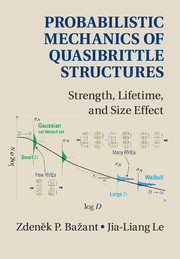Book contents
- Frontmatter
- Dedication
- Contents
- Foreword
- Preface
- 1 Introduction
- 2 Review of Classical Statistical Theory of Structural Strength and Structural Safety, and of Statistics Fundamentals
- 3 Review of Fracture Mechanics and Deterministic Size Effect in Quasibrittle Structures
- 4 Failure Statistics of Nanoscale Structures
- 5 Nano–Macroscale Bridging of Probability Distributions of Static and Fatigue Strengths
- 6 Multiscale Modeling of Fracture Kinetics and Size Effect under Static and Cyclic Fatigue
- 7 Size Effect on Probability Distributions of Strength and Lifetime of Quasibrittle Structures
- 8 Computation of Probability Distributions of Structural Strength and Lifetime
- 9 Indirect Determination of Strength Statistics of Quasibrittle Structures
- 10 Statistical Distribution and Size Effect on Residual Strength after Sustained Load
- 11 Size Effect on Reliability Indices and Safety Factors
- 12 Crack Length Effect on Scaling of Structural Strength and Type 1 to 2 Transition
- 13 Effect of Stress Singularities on Scaling of Structural Strength
- 14 Lifetime of High-k Gate Dielectrics and Analogy with Failure Statistics of Quasibrittle Structures
- Appendix A Power-Law Scaling of Boundary Value Problems
- Appendix B Proof of Transitional Size Effects of Types 1 and 2 by Dimensional Analysis and Asymptotic Matching up to Second Order
- Appendix C Proof of Small-Size Asymptotics of Cohesive Crack Model up to Second Order
- References
- Author Index
- Subject Index
10 - Statistical Distribution and Size Effect on Residual Strength after Sustained Load
Published online by Cambridge University Press: 14 June 2017
- Frontmatter
- Dedication
- Contents
- Foreword
- Preface
- 1 Introduction
- 2 Review of Classical Statistical Theory of Structural Strength and Structural Safety, and of Statistics Fundamentals
- 3 Review of Fracture Mechanics and Deterministic Size Effect in Quasibrittle Structures
- 4 Failure Statistics of Nanoscale Structures
- 5 Nano–Macroscale Bridging of Probability Distributions of Static and Fatigue Strengths
- 6 Multiscale Modeling of Fracture Kinetics and Size Effect under Static and Cyclic Fatigue
- 7 Size Effect on Probability Distributions of Strength and Lifetime of Quasibrittle Structures
- 8 Computation of Probability Distributions of Structural Strength and Lifetime
- 9 Indirect Determination of Strength Statistics of Quasibrittle Structures
- 10 Statistical Distribution and Size Effect on Residual Strength after Sustained Load
- 11 Size Effect on Reliability Indices and Safety Factors
- 12 Crack Length Effect on Scaling of Structural Strength and Type 1 to 2 Transition
- 13 Effect of Stress Singularities on Scaling of Structural Strength
- 14 Lifetime of High-k Gate Dielectrics and Analogy with Failure Statistics of Quasibrittle Structures
- Appendix A Power-Law Scaling of Boundary Value Problems
- Appendix B Proof of Transitional Size Effects of Types 1 and 2 by Dimensional Analysis and Asymptotic Matching up to Second Order
- Appendix C Proof of Small-Size Asymptotics of Cohesive Crack Model up to Second Order
- References
- Author Index
- Subject Index
Summary
In many engineering applications, the risky overload would not occur right at the first load application. This chapter, based mostly on Salviato, Kirane, & Bažant (2014), deals with the residual strength of a structure at an accidental sudden overload that occurs later, after a period of sustained load high enough to weaken the structure. The residual strength is also important in the laboratory since, as will be shown, it is advantageous to replace lifetime tests by residual strength tests.
Practical examples of overload include an earthquake, a sudden excessive traffic load on a bridge, an excessive rise of water level behind a dam, accidental impact, or sudden overheating of an electronic component. Knowledge of the statistics of residual strength should allow improvements in the safety factors, taking into account the strength degradation of the structure depending on the load history and duration. It should also allow meaningful estimates of the remaining service life of structures for which maintenance design is a primary concern. This is of paramount importance from the perspective of cost reduction and safety, especially for modern large aircraft made of load-bearing quasibrittle composites (Lee, Ma, Thimm, & Verstraeten 2008).
The residual strength of different materials has been widely studied phenomenologically, but mainly for the case of cyclic loading. For example, Yang and Liu proposed a model for residual strength degradation and periodic proof tests for graphite-epoxy laminates under cyclic loading (Yang & Liu 1977; Yang 1978). A mechanistic attempt was provided by Halpin, Johnson, & Waddoups (1972), based on the kinetics of fracture growth. There have been some experimental studies, e.g., for concrete (Award & Hilsdorf 1972), but strictly deterministic. Unfortunately, no information exists in the literature on the residual strength in the statistical sense. In those few attempts that provided a statistical perspective (Kirchner & Walker 1971; Evans 1974; Hahn & Kim 1975; Thomas, Verrilli, & Calomino 2002; Duffy et al. 2003), the quasibrittleness of the structure was not considered.
- Type
- Chapter
- Information
- Probabilistic Mechanics of Quasibrittle StructuresStrength, Lifetime, and Size Effect, pp. 177 - 192Publisher: Cambridge University PressPrint publication year: 2017



